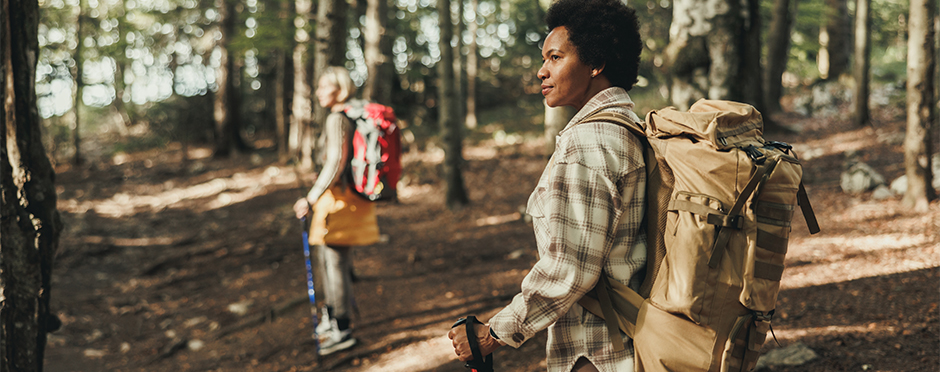
Tips for Hiking with Knee Arthritis
Leave a CommentHeading out for a hike can challenge individuals with knee arthritis. The sharp or aching pain you experience can slow down or even prevent you from hitting the trails. However, with the right guidance and strategies, you can still be an active hiker despite knee arthritis. In this blog post, we’ll review insights and recommendations from a physical therapist’s perspective to help hikers manage knee arthritis and continue exploring the outdoors safely and comfortably.
First, let’s understand knee arthritis, specifically osteoarthritis. Our knee’s major joint comprises of the end of two bones: the femur (upper leg) and tibia (lower leg). Normally, these two bone ends are covered with a cartilage layer to help reduce friction and provide some force absorption. With osteoarthritis, the layer of cartilage is disrupted; either the cartilage is softened, thinned, or absent in more advanced cases. This means the knee is more stiff and less resilient to shock absorbing. While both factors can increase pain and swelling, they can also be managed. Here are seven tips to continue enjoying a good hike despite knee arthritis!
1. Get a Free Assessment
Before embarking on a hiking adventure, it’s crucial to assess your knee arthritis condition with a physical therapist. A comprehensive assessment can help identify specific limitations, strengths, and areas for improvement. This is especially important if you plan a multi-day hiking trip, which a flare-up of knee pain could completely derail. Based on your assessment, your physical therapist can provide recommendations to optimize your hiking ability while minimizing the risk of injury.
2. Strengthening Exercises
You want to start an exercise program to strengthen the muscles surrounding the knee joint, as well as the hip and ankle joints. Focus on exercises that improve quadriceps, hamstrings, glutes, and calf strength. Work within your experience and personal tolerance, but focus on exercises such as squats, lunges, deadlifts, box step-ups, and hamstring curls. Machines can be beneficial and well tolerated if you have knee pain but try to incorporate bodyweight or free-weight exercises to mimic the physical demands of hiking. Strengthening these muscle groups can help provide better support to the knee joint, reduce pain, and enhance overall functional ability during hiking.
3. Flexibility and Mobility Training
Incorporate regular stretching and mobility exercises to improve flexibility and range of motion in the knee joint and surrounding muscles. Dynamic stretches, foam rolling, and mobility drills can loosen tight muscles and enhance joint mobility, which can help reduce stiffness and discomfort during hiking.
4. Footwear and Trekking Poles
Invest in high-quality hiking gear and equipment to provide optimal knee support and protection. Choose hiking shoes or boots with excellent cushioning, stability, and ankle support to minimize impact and enhance stability on uneven terrain. Poor grip can lead to slipping, and poor cushioning can lead to early fatigue, likely resulting in knee pain with arthritis. Trekking poles are a worthwhile investment to distribute weight evenly and reduce the load on the knees, especially during descents.
5. Pain Management Strategies
Implement pain management strategies to alleviate discomfort and improve hiking tolerance. This may include using heat or cold therapy, over-the-counter pain relievers, or topical analgesics to manage acute pain and inflammation. Additionally, pacing yourself, taking rest breaks, and using mindfulness techniques can help regulate pain perception and enhance endurance during hikes.
6. Gradual Progression
Gradually increase the intensity and duration of your hikes to allow your body to adapt and build endurance progressively. Start with shorter, less strenuous trails and gradually advance to longer or more challenging routes as your strength and confidence improve. In endurance sports such as running and cycling, the general rule is to keep any weekly distance increases to 10-15%. For example, if you hiked 15 total miles in a week, aim for 17.25 total miles or less the next week.
7. Environmental Considerations
Be mindful of environmental factors that may exacerbate knee arthritis symptoms during hiking. Avoid hiking in extreme weather conditions, such as extreme heat or cold, as temperature changes can affect joint stiffness and discomfort. When on a trail, stick to the flattest section, instead of walking on the crowned or slanted edges. On terrain where this is not an option, plant the tips of your trekking poles on either side of your unstable foot to spread your body weight.
By incorporating strengthening exercises, flexibility training, biomechanical analysis, proper gear, and pain management strategies, individuals with knee arthritis can continue to pursue their passion for hiking while minimizing the impact on their joints. Remember, with the right approach and support, hiking can be therapeutic and empowering for individuals with knee arthritis. If you have any questions or need help getting into hiking, reach out to Athletico Physical Therapy to get set up with a therapist who can help you!
*Per federal guidelines, beneficiaries of plans such as Medicare, Medicaid, Tricare, VHA and other federally funded plans are not eligible for free assessments.
The Athletico blog is an educational resource written by Athletico employees. Athletico bloggers are licensed professionals who abide by the code of ethics outlined by their respective professional associations. The content published in blog posts represents the opinion of the individual author based on their expertise and experience. The content provided in this blog is for informational purposes only, does not constitute medical advice and should not be relied on for making personal health decisions.
